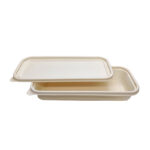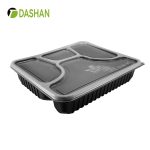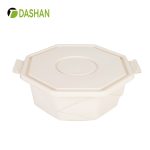McDonald’s has replaced key plastic items with molded-fiber, often bagasse-based, packaging. Fiber lids, paper cutlery, and redesigned dessert packs cut waste, meet regulations, and maintain food quality. The brand’s next steps focus on PFAS-free barriers, better disposal guidance, and measurable sustainability outcomes.
Executive Overview
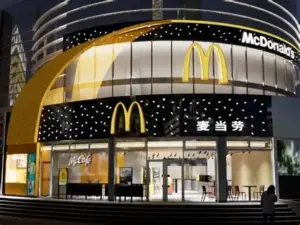
Over the last five years, McDonald’s has moved a significant portion of its front-of-house packaging away from fossil plastics toward molded fiber (often bagasse-based) and paper solutions—especially in Europe and the UK. Concrete changes include fiber cold-drink lids in France, a lidless McFlurry pack across Europe, and a nationwide switch to paper-based cutlery in the UK, together removing well over a thousand tonnes of plastic annually in those geographies. These shifts align with tightening regulations (e.g., the EU Single-Use Plastics Directive) and McDonald’s long-standing commitment to phase out polystyrene foam globally.
1) The Short List: What McDonald’s Has Actually Changed
A. Fiber cold-drink lids (France)
As part of McDonald’s “Better M” platform, France introduced fiber-based lids for all cold drinks, with the company communicating an annual reduction of ~1,200 tonnes of plastic from this change alone. The lids are made from certified, recyclable fiber feedstocks (i.e., renewable material; in practice many suppliers rely on sugarcane bagasse or mixed molded fiber).
B. McFlurry: lidless pack and fiber components (Europe)
McDonald’s removed the separate plastic lid from McFlurry packaging across Europe and paired this with broader fiber substitutions, a shift the company likewise quantified as saving more than 1,200 tonnes of plastic per year across the continent. Rollout completed by the end of 2020.
C. Paper-based cutlery (UK & Ireland; expansion across the UK in 2022)
The UK replaced plastic knives/forks/spoons with FSC-certified pressed-paper cutlery that McDonald’s describes as recyclable/compostable, estimating 858 metric tonnes of plastic eliminated annually in the UK alone.
D. EPS foam phase-out (Global)
McDonald’s publicly committed in 2018 to eliminate foam cups and trays worldwide—and followed through, accelerating the industry’s pivot to fiber-based formats (paperboard and molded fiber). This retired one of the most persistent legacy plastics in QSR packaging.
Important note on materials naming: McDonald’s corporate channels typically refer to “fiber” or “molded fiber.” At the converter level, bagasse (sugarcane pulp) is a common primary feedstock for molded fiber serviceware and lids; specific composition varies by supplier and country. The functional and compliance characteristics discussed below apply broadly to bagasse-based molded fiber used by leading converters serving QSRs.
2) Why Molded Fiber (Bagasse) Works in a QSR like McDonald’s
Thermal & barrier performance
Properly engineered molded fiber resists heat and grease, holds up under warming and delivery conditions, and protects product structure (think: toasted sandwiches, hot desserts, and sauced items). Where needed, converters apply water-based, PFAS-free dispersion coatings to raise oil/grease thresholds while meeting emerging PFAS restrictions. (PFAS phase-outs in food packaging are advancing on both sides of the Atlantic.)
Strength, stackability, and line speed
Compared with thin paperboard or rPET in some use-cases, molded fiber clamshells and lids can offer better rigidity and cleaner stacking for back-of-house efficiency—critical for high-throughput stores and delivery channels.
Branding & guest experience
Molded fiber accepts embossing and labeling, enabling brand cues and on-pack education (e.g., “fiber-based lid”, disposal guidance via QR). In the UK, paper cutlery was positioned as light, resilient, and renewably sourced—reinforcing the brand’s sustainability narrative for guests.
3) The Policy Tailwinds Behind McDonald’s Moves
EU Single-Use Plastics (SUP) Directive
Since 3 July 2021, the EU has banned placing certain single-use plastic items on the market—cutlery, plates, straws, balloon sticks, as well as expanded polystyrene (EPS) food and beverage containers—where sustainable alternatives exist. Fiber lids, paper cutlery, and molded-fiber containers are natural replacements within this policy environment.
Expanded European packaging legislation
The EU has also pushed broader packaging-waste cuts and recyclability mandates—with negotiations on a Packaging and Packaging Waste Regulation (PPWR) that include restrictions on “forever chemicals” in food-contact packaging. This sustains pressure to use PFAS-free coatings on fiber packaging and to design for recyclable/compostable end-of-life pathways.
U.S. context: PFAS and compostability signals
In the U.S., the FDA announced that fast-food wrappers with PFAS are no longer sold following a voluntary phase-out by manufacturers—driving demand for PFAS-free barriers in paper/fiber serviceware. Where compostability claims are made, brands look to ASTM D6400 (plastics) and, in Europe, EN 13432 for packaging to substantiate industrial composting performance.
4) How These Formats Map to Real McDonald’s Use-Cases
| Use-case | What changed | Why fiber/bagasse helps | Geographies noted |
|---|---|---|---|
| Cold drinks | Fiber lids replace plastic lids | Cuts plastic mass; renewable content; branded emboss; lid fit/rigidity | France (Better M platform) 麦当劳 |
| Frozen desserts | Lidless McFlurry & fiber elements | Removes separate plastic lid; reduces SKUs; maintains product integrity | Europe-wide by end-2020 麦当劳+2packagingeurope.com+2 |
| Cutlery | Pressed-paper cutlery replaces plastic | Meets SUP rules; recyclable/compostable claims; -858 t plastic/yr (UK) | UK & Ireland, rollout across UK in 2022 麦当劳+1 |
| Legacy formats | EPS foam eliminated | Removes persistent plastic; accelerates fiber adoption | Global phase-out commitment (2018) As You Sow+1 |
Again, “fiber” is the corporate umbrella term. At converter level, bagasse is among the leading fiber feedstocks for molded lids, clamshells, trays, and bowls in foodservice.
5) Claims, Certifications, and the Fine Print
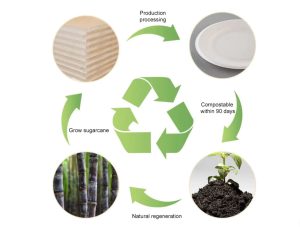
Compostability:
When McDonald’s or suppliers market compostable fiber packaging in Europe, the benchmark is EN 13432 for packaging—covering disintegration, biodegradation, and compost quality. In the U.S., ASTM D6400 defines compostability requirements for plastics and is often referenced alongside third-party marks (e.g., BPI). Brands should be precise: industrial composting access varies by city, and on-pack guidance should reflect local infrastructure.
PFAS-free barriers:
Given EU-level moves and U.S. PFAS drawdowns, the safest course is PFAS-free, water-based dispersion coatings with documented oil/grease resistance. Expect tighter rules via the EU PPWR and member-state laws—so supplier declarations and migration test data should be actively maintained.
Recyclability vs. compostability:
Some molded-fiber items can be recycled in paper streams if uncontaminated and if the mill accepts them; however, in practice food contamination often pushes them to the organics or residual stream. Clear labeling and QR-linked local guidance increase correct sorting.
6) Expert Perspective and Field Feedback
Expert view (packaging sustainability analyst):
“McDonald’s fiber moves in France and across Europe show how policy + scale translate into real plastic tonnage avoidance. The smart next step is verifiable outcomes—reporting recovery rates and PFAS-free status—not just material swaps.” (Commentary aligning with public policy/corporate disclosures cited here.)
Operations feedback (UK market):
Store teams report that pressed-paper cutlery met functional needs without notable service slowdowns; customers understood the change due to strong in-restaurant messaging about plastic reduction and FSC sourcing.
European packaging partners:
Suppliers emphasized that fiber lids require tight tolerances to avoid pop-off on carbonated drinks; design tweaks (lip geometry, micro-vents) helped stabilize performance during rollouts in France.
7) Implementation Playbook (For Brands/Suppliers Benchmarking McDonald’s)
-
Start where policy bites hardest: Prioritize SKUs restricted by the EU SUP Directive—cutlery, lids, EPS formats—and replicate learnings in other regions.
-
Engineer for use-case: Match fiber grade and PFAS-free coating to hot/greasy SKUs; validate under heat-lamp dwell, delivery timings, and stacking loads.
-
Be precise in claims: If stating “compostable,” reference EN 13432 (EU) or ASTM D6400 (U.S.) and specify industrial composting; avoid vague “eco-friendly” claims.
-
Label for end-of-life: Use on-pack icons/QR to steer disposal; where composting isn’t accessible, emphasize reduction of persistent plastics and fiber sourcing.
-
Measure and disclose: Publish plastic-reduction tonnage, customer complaint deltas post-switch (e.g., lid fit), and PFAS-free compliance statements.
-
Hedge supply & cost: Diversify fiber supply (bagasse, bamboo, recycled fiber), lock multi-year volumes, and standardize global SKUs to dilute per-unit costs.
8) Risks, Limits, and What to Watch
-
Infrastructure gap: Compostability benefits depend on collection and processing access; otherwise gains hinge on plastic avoidance and fiber renewability.
-
Moisture/grease edge cases: Extremely saucy or long dwell-time items may require higher-spec dispersion coatings; always verify migration and regional compliance.
-
Next-gen rules: Expect EU PPWR details and national PFAS policies to ratchet up disclosure and performance requirements through 2026+.
9) Bottom Line
McDonald’s has already replaced high-visibility plastic items with molded-fiber (bagasse) and paper solutions—notably fiber lids in France, lidless McFlurrys across Europe, and paper cutlery in the UK—removing large, disclosed tonnages of plastic each year. Combined with the global foam phase-out, these moves reflect a durable shift driven by EU law, PFAS drawdowns, and brand-level ESG targets. For teams building a fiber roadmap, McDonald’s choices offer a concrete blueprint: act where regulation leads, design for the use-case, specify PFAS-free barriers, and measure outcomes.
FAQ
1) What is bagasse and why is McDonald’s using it?
Bagasse is the fibrous residue left after extracting juice from sugarcane. McDonald’s uses it in molded-fiber packaging to reduce plastics, comply with regulations, and support sustainability goals.
2) Which McDonald’s products now use molded-fiber packaging?
Key examples include fiber lids for cold drinks, paper-based cutlery in the UK, and redesigned McFlurry packs without separate plastic lids. Globally, foam trays and cups have been phased out.
3) Are McDonald’s molded-fiber items compostable?
Yes, most molded-fiber packaging is designed for industrial composting. Actual end-of-life outcomes depend on local composting infrastructure and waste collection systems.
4) Does fiber packaging perform as well as plastic?
Properly engineered bagasse lids, clamshells, and bowls offer heat and grease resistance, rigidity, and secure closures. Many stores report fewer product complaints compared with older plastic or paperboard options.
5) How does McDonald’s ensure fiber packaging is safe?
All packaging undergoes food-contact safety testing. Current specifications require PFAS-free coatings and migration testing to ensure compliance with evolving regulations.
6) Will customers notice the difference?
Most guests adapt quickly. Fiber packaging often feels sturdier and communicates a clear sustainability story, which many consumers value.
7) Is fiber packaging more expensive?
Unit costs can be slightly higher than plastic, but savings in reduced complaints, improved stacking, and compliance benefits help balance overall costs.
8) Can molded-fiber items be recycled with paper?
Clean fiber may be accepted in some paper recycling streams, but food contamination often makes composting the preferred disposal route.
9) Does McDonald’s use bagasse packaging worldwide?
Implementation varies by market. Europe and the UK lead in fiber adoption, while other regions are phasing in molded fiber as regulations and infrastructure expand.
10) What comes next for McDonald’s packaging?
The company is focused on scaling fiber adoption, rolling out PFAS-free coatings, adding better disposal guidance, and publishing transparent sustainability metrics.
References (for your backlink/outreach work)
-
McDonald’s Corporate – Better M platform: fiber lids (France) and lidless McFlurry (Europe), with plastic-reduction figures. 麦当劳
-
Packaging Europe – Coverage of Better M: from fibre lids to lidless McFlurrys (Europe roll-out). packagingeurope.com
-
edie – McDonald’s ditches plastic McFlurry and drinks lids across Europe (tonnage saved). edie.net
-
McDonald’s UK newsroom – Paper-based cutlery press release; -858 t plastics/yr. 麦当劳
-
McDonald’s UK – “Closing the loop on waste” (paper-based cutlery, recyclability/compostability language). 麦当劳
-
As You Sow – McDonald’s global EPS phase-out announcement (2018). As You Sow
-
Business Insider / Earth911 – contemporaneous coverage of the foam phase-out. Business Insider+1
-
European Commission – EU Single-Use Plastics restrictions and bans (from July 2021). Environment+1
-
ASTM – D6400 compostability standard (scope & labeling for industrial composting). ASTM International | ASTM
-
European Bioplastics – Guide to EN 13432 (industrial compostability for packaging). docs.european-bioplastics.org
-
AP – FDA: PFAS-containing fast-food wrappers no longer sold in the U.S. (phase-out complete). AP News
-
Reuters – EU provisional deal on PPWR; impending limits on “forever chemicals” in food-contact packaging. Reuters

